Hammock Camping Mistakes to Avoid
Hammock camping is a great way to enjoy the outdoors and get a good night’s sleep. However, it’s important to be aware of the common hammock camping mistakes that campers make so that you can avoid them and have a safe and enjoyable experience.
I’ve been hammock camping for over 12 years now, and I’ve made my fair share of mistakes along the way. But I’ve also learned a lot, and I’m here to share some of my hammock mistakes with you as well as many tips on how to avoid them.
“Hammock camping is a great way to enjoy the outdoors and get a good night’s sleep. However, it’s important to be aware of the common mistakes hammock campers make so that you can avoid them and have a safe and enjoyable experience.”
John Smith, outdoor expert
Using the wrong hammock
In the heart of the wilderness, my friend Tom learned a vital lesson about hammock camping. Excited for his first night under the stars, he hastily picked the wrong hammock.
The night turned into a wrestling match with discomfort, prompting Tom to learn about the importance of choosing the right hammock for his next hammock camping trip.
There are many different types of hammocks available, so it’s important to choose one that is right for you. Consider the size of the hammock, the weight capacity, and the type of material.
Not using tree protectors
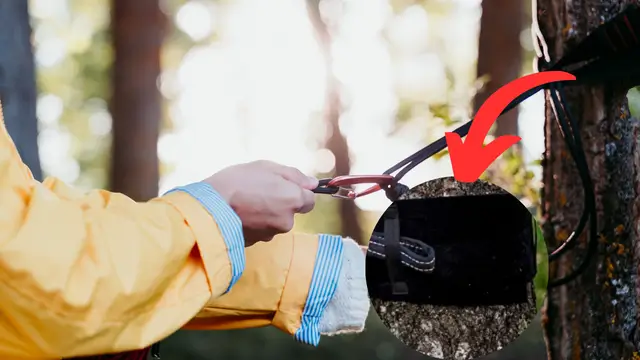
Tree protectors are essential for protecting the trees you’re using to hang your hammock.
Without tree protectors, your hammock straps can damage the bark and even kill the trees.
To avoid this mistake, always use tree protectors when hanging your hammock. You can buy tree protectors online or at most outdoor gear stores.
Hanging your hammock too tight
Improper angle for the hammock suspension is a significant issue in hammock camping, and it can result in discomfort or instability during use. This is exactly what my friend, Alex, faced while setting up his hammock.
The recommended solution to this problem is to ensure a proper angle of 30 degrees for the hammock suspension. Personally I use these two effective methods to achieve this:
- Finger and Thumb Method: Using your finger and thumb to gauge and maintain the correct angle ensures a secure and comfortable hammock setup.
- Ridge Line Technique: Implementing a ridge line offers a reliable way to achieve and maintain the recommended 30-degree angle, contributing to a stable and enjoyable hammock experience.
Read more about How To Hang A Camping Hammock In 5 Easy Steps
Not using an underquilt
An underquilt is a sleeping bag that hangs underneath your hammock. It’s essential for staying warm on cold nights.
If you don’t have an underquilt, you’ll likely wake up cold and uncomfortable.
Not bringing a tarp
A tarp is a piece of waterproof fabric that protects you from the elements. It’s essential for hammock camping, even in good weather.
A tarp can protect you from rain, sun, and wind. It can also be used to create a cooking area or a place to relax during the day.
Be prepared for all weather conditions
Mother Nature can be unpredictable, especially when you’re camping. It’s important to be prepared for anything, even if the weather forecast looks good.
This means packing layers of clothing, rain fly, and a warm sleeping bag or quilt. Always pack for all types of weather conditions, and be prepared to change your plans if necessary.
Not using hammock straps
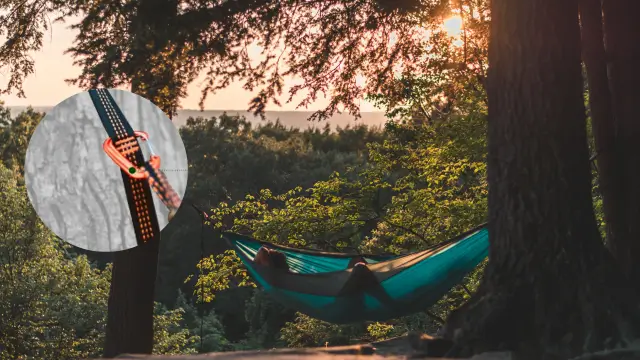
Hammock straps are essential for hanging your hammock safely and securely. Never use ropes or bungee cords to hang your hammock, as these can break and cause you to fall.
Hammock straps are specifically designed for hanging hammocks and are much safer than ropes or bungee cords.
Not checking hammock sag
It’s important to check your hammock sag regularly, especially after a long day of hiking or camping.
The sag can change over time, so it’s important to make sure it’s still at a comfortable level.
To check your hammock sag, lie in your hammock and measure the distance from the center of the hammock to the ground. The ideal hammock sag is about 30 degrees.
“One of the best tips for hammock camping is to start by practicing in your backyard. This will help you to learn how to tie the necessary knots and to adjust the sag of your hammock.”
Jane Doe, hammock camping enthusiast
Preventing hammock slide
Hammock slide is when your hammock moves along the straps, making it difficult to get in and out of.
To prevent hammock slide, you can use hammock knots or hammock sliders.
- Hammock knots are a simple and effective way to prevent hammock slide.
- Hammock sliders are a more expensive option, but they’re easier to use.
Selecting trees for hammock camping
When selecting trees to hang your hammock from, it’s important to choose strong, healthy trees. Avoid trees that are dead, diseased, or have weak branches.
It’s also important to choose trees that are spaced far enough apart so that your hammock can hang comfortably. Read about How Big Does A Tree Need To Be For A Hammock?
Tree distance for hammock setup
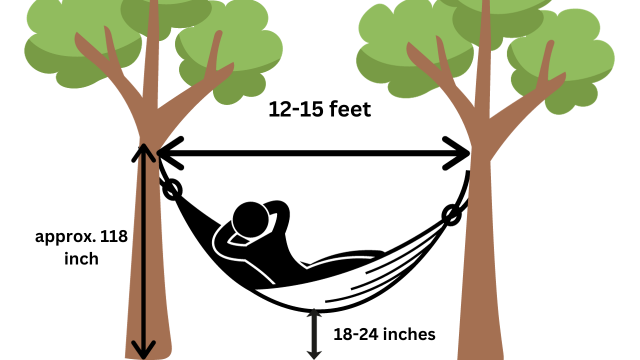
The ideal tree distance for hammock setup is about 12-15 feet.
This distance will allow you to hang your hammock comfortably and will also give you enough space to set up your tarp and other gear.
“It’s also important to choose a campsite with two trees that are spaced about 12-15 feet apart. This will give you enough room to hang your hammock comfortably and to set up your tarp and other gear.”
Bill Jones, hammock camping expert
For more information, read our article about The Ideal Distance Between Trees For Hammock Camping
Incorrect Way of Laying in the Hammock
Here, we return to Tom, where he declares: In addition to using the wrong hammock, laying straight in the hammock resembling the shape of a banana made me lean into discomfort and get a restless night.
So, to enhance comfort and ensure a better night’s sleep, I recommend laying asymmetrically to achieve a more comfortable and flat position.
“When laying in a hammock, it’s important to avoid laying straight. This can lead to discomfort and a poor night’s sleep. Instead, try laying diagonally in the hammock. This will help to distribute your weight evenly and make for a more comfortable sleeping experience.”
Bill Jones, hammock camping expert
Recommended Reading: Tips For Sleeping In A Camping Hammock & How to Sleep in a Hammock
Poisonous plants awareness
When camping, it’s important to be aware of poisonous plants. Some poisonous plants can cause serious health problems, even death.
Before you go camping, take some time to learn about the poisonous plants that are common in your area.
Hammock bug net
A hammock bug net is essential for protecting you from insects, especially mosquitoes.
Mosquitoes can carry diseases such as malaria and dengue fever, so it’s important to take steps to protect yourself.
If you don’t have a hammock bug net, you can use insect repellent or a sleeping bag with a built-in bug net.
Hammock height
The ideal hammock height is about 18-24 inches from the ground. This height will help you get in and out of your hammock easily and will also protect you from the elements.
- If you hang your hammock too high, you’ll risk falling when you get in and out of it.
- If you hang your hammock too low, you’ll be more exposed to the elements and may also be more likely to get bitten by insects.
Preventable falls in hammock
Falls are one of the most common injuries in hammock camping. To avoid falls, it’s important to be careful when getting in and out of your hammock.
Here are some tips for preventing falls in hammock camping:
- Always use a hammock bug net. This will help you avoid getting bitten by insects and losing your balance.
- Get in and out of your hammock slowly and carefully.
- Don’t hang your hammock too high (about 18-24 inches from the ground).
- Be aware of your surroundings. Avoid hanging your hammock near rocks, roots, or other obstacles.
Tarp staking
When staking your tarp, it’s important to use strong stakes and to stake the tarp securely. This will help prevent your tarp from blowing away in the wind.
Here are some tips for tarp staking:
- Use strong stakes that are at least 12 inches long.
- Stake the tarp at all four corners and at least two midpoints on each side.
- Angle the stakes away from the tarp to create a tensioned surface.
- Use guy lines to provide additional support for your tarp.
Drip lines for hammock
Drip lines are a great way to protect yourself from rain and condensation. They are simply ropes or cords that are strung from the tarp to the ground.
They help to direct rainwater and condensation away from your hammock.
To set up drip lines:
- Tie a rope or cord to the tarp at one end and to the ground at the other end.
- Make sure the rope or cord is taut, but not too tight.
- Tie another rope or cord to the tarp at a point about 1/3 of the way from the end and to the ground at a point about 2/3 of the way from the end.
- Repeat this process for the other side of the tarp.
Fire safety in hammock camping
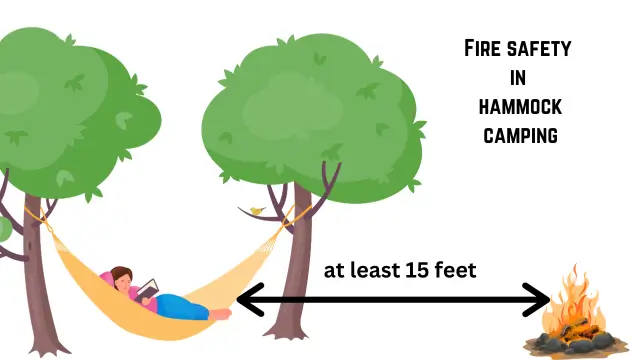
Fire safety is important in all camping situations, but it’s especially important in hammock camping.
Hammocks are made of flammable materials, so it’s important to keep them away from fires.
Here are some tips for fire safety in hammock camping:
- Build your campfire at least 15 feet away from your hammock.
- Never leave your campfire unattended.
- Extinguish your campfire completely before going to bed.
Leave-no-trace camping
Leave-no-trace camping is a set of principles that help to protect the wilderness. When hammock camping, it’s important to leave no trace of your visit.
Here are some tips for leave-no-trace hammock camping:
- Pack out all of your trash.
- Leave the campsite as you found it.
- Avoid using soap or detergent in streams or lakes.
- Be respectful of wildlife.
Hammock camping restrictions
Some areas have restrictions on hammock camping. It’s important to check the regulations for the area where you’re planning to camp before you go.
Hammock camping tips for beginners
- Start by practicing hanging your hammock in your backyard. This will help you to learn how to tie the necessary knots and to adjust the sag of your hammock.
- Choose a campsite with two trees that are spaced about 12-15 feet apart.
- Make sure the trees are strong and healthy. Avoid trees that are dead, diseased, or have weak branches.
- Hang your hammock at a comfortable height. The ideal hammock height is about 18-24 inches from the ground.
- Use hammock straps to hang your hammock safely and securely. Never use ropes or bungee cords to hang your hammock.
- Use a tarp to protect yourself from the elements. Even in good weather, it’s important to have a tarp to protect yourself from the sun and rain.
- Use an underquilt to stay warm on cold nights.
- Use a hammock bug net to protect yourself from insects.
- Be careful when getting in and out of your hammock. Falls are one of the most common injuries in hammock camping.
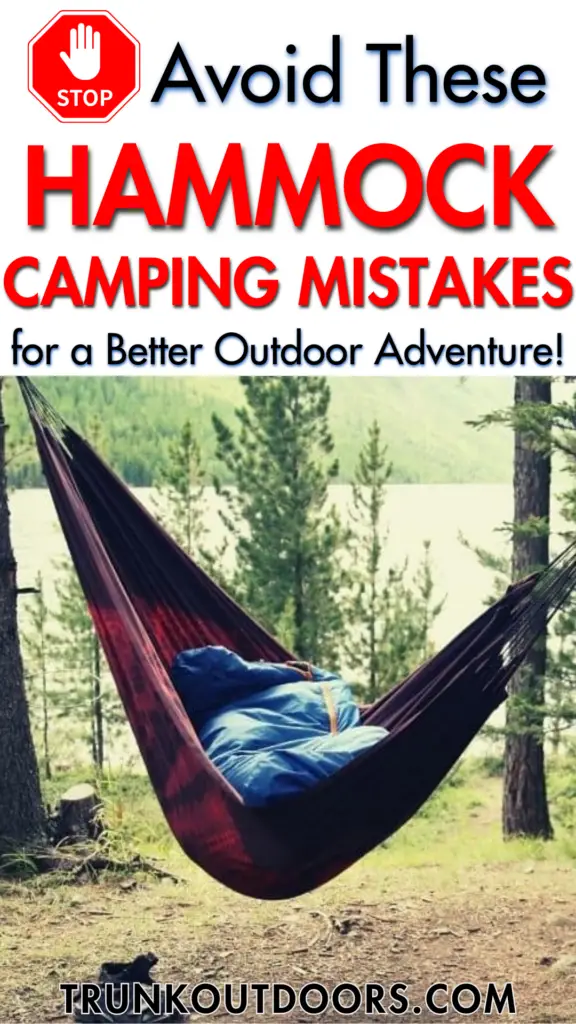
Conclusion
Hammock camping is a great way to enjoy the outdoors and get a good night’s sleep.
However, it’s important to be aware of the common mistakes hammock campers make so that you can avoid them and have a safe and enjoyable experience.
By following the tips in this article, you can learn how to set up your hammock correctly, avoid falls, and stay safe and comfortable while hammock camping.